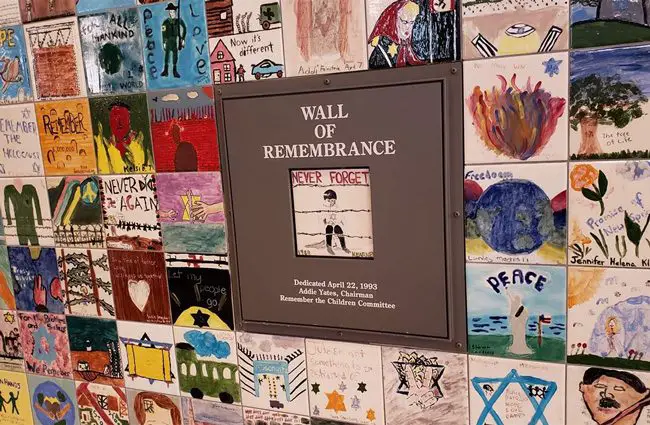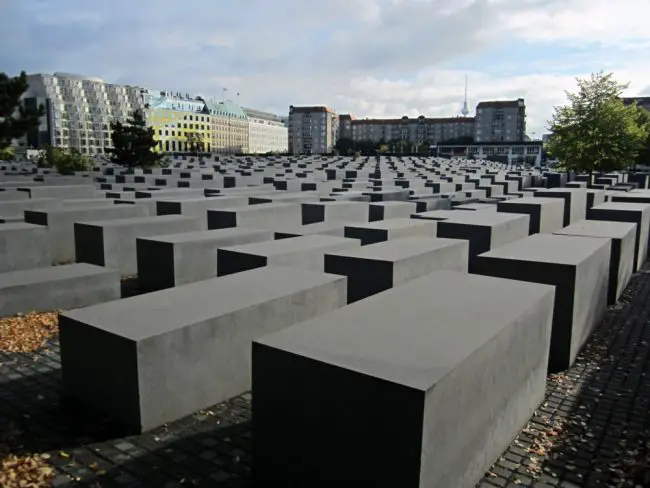
Claire Sarnowski of Lake Oswego, Oregon, met Holocaust survivor Alter Wiener at a school event five years ago when she was 9 years old.
Because her aunt had arranged the talk by the Holocaust survivor, and served as his escort to the school and back, Sarnowski got to ride along when Wiener was driven home. The two started talking and formed an immediate bond. They kept in touch, with Sarnowski often persuading someone to drive her to see Wiener at his home in Hillsboro, Oregon, about an hour away from where he spoke. They shared meals and stories. Sarnowski became increasingly interested in Wiener’s tales of living under Hitler during World War II and his life since then.
She thought other kids should learn about them too and began a campaign to get a state law requiring Holocaust education in Oregon schools. Last month, Democratic Gov. Kate Brown signed that law, with Sarnowski, now age 14, looking on. Even though Wiener died late last year at 92, Oregon students will continue to learn the lessons he shared.
Oregon is the 12th state to enact such a law, according to the Anti-Defamation League. Most of the states have acted in the past few years, and bills are pending in another dozen states.
In a telephone interview, Sarnowski said it’s very hard for young people to relate to the Holocaust, particularly in that there are fewer survivors around for them to talk to. It was the personal talks with Wiener, she said, that made it real for her. Surveys show that Sarnowski’s instinct is on target regarding young people.
Ignorance about the Holocaust is growing, particularly among young people. A survey last year showed that two-thirds of U.S. millennials were not familiar with Auschwitz, the largest Nazi death camp complex, located near Krakow, Poland. More than 1.1 million people were gassed, shot or starved at Auschwitz, including nearly a million Jews. Overall, the Nazis murdered 6 million Jews during the Holocaust, plus millions of Roma, homosexuals and others.
The Holocaust was the largest genocide in history, but not the last one. More recent examples include the Khmer Rouge’s killing of about 2 million Cambodian dissidents between 1975 and 1979; the Hutu slaughter of about 800,000 mostly Tutsis in Rwanda in 1994; and the Sudanese government’s killing of 300,000 civilians in the Darfur region, beginning in 2003.
“For me, being able to hear stories of survivors … that connection was the most valuable piece of my education,” said Sarnowski, who is not Jewish. “Just to know what happened, what led up to it … and that this is considered our recent history. It’s important to learn for the future and what we can do to make a difference in our own community. How we can stop the persecution of people in our schools for racial, religious [reasons] or just people who are different.”
She forged a special bond with Wiener, who was born in 1926 in Chrzanow, Poland, near the German border. When the Germans invaded Poland in 1939, Wiener, his stepmother and his brothers fled, leaving his father, a grocer, behind to supply Nazi troops with food. When the family returned three months later, their father had been killed. Wiener, then 13, was sent to several concentration camps and was eventually freed by Russian troops in 1945. The rest of his family died.

Wiener moved to what was then Palestine after the war and eventually joined cousins in the United States, according to the Oregon Jewish Museum and Center for Holocaust Education. He moved to Oregon in 2000 and began speaking to student groups, eventually making about a thousand appearances in schools, the museum said.
Sarnowski visited Wiener nearly every week in the last couple of years of his life, she said, hearing his stories over and over and becoming special friends.
When the two approached Oregon state Sen. Rob Wagner, a Democrat, about passing a law, Wagner sensed that feeling too. “That friendship was pretty magical,” he said by telephone from his Lake Oswego home. He said the planned 15-minute meeting lasted 2½ hours and — along with work with Oregon Jewish groups and Holocaust educators — led to the bill that became law.
Wagner also said he was spurred to act by the rise of anti-Semitism in his neighborhood in suburban Portland. “Near a synagogue in my own neighborhood, there were anti-Semitic posters put up on light poles,” he said. “There’s definitely a rise in racism and anti-Semitism in the last couple of years.”
The point was underscored in hearings in the Oregon legislature on the bill. In a House hearing in May, several people presented testimony that denied the Holocaust took place and said the deaths were exaggerated. Salem resident Tom Madison, in his written testimony, said there were “no gas chambers capable of killing humans” and “Soviet propaganda created the Nazi ‘death camp’ myth.”
The testimony got so emotional that Education Committee Chairwoman Margaret Doherty, a Democrat, recessed the hearing to allow members to compose themselves. The bill passed unanimously.
Sondra Perl, director of U.S. programs for the Olga Lengyel Institute for Holocaust Studies and Human Rights in New York City, said most programs on the Holocaust, including her organization’s, stick strictly to historical fact so as “not to give fuel to deniers.”
That institute, the U.S. Holocaust Memorial Museum, the Shoah Holocaust remembrance foundation and other organizations are creating a rich catalogue of survivors’ stories — many on video recordings — to preserve their experiences even after they die. “When they are gone, the eyewitnesses will be gone,” Perl said.
The Anti-Defamation League, which keeps tabs on hate crimes nationwide, and — along with the FBI — statistics on incidents, reported that anti-Semitic acts hit near record levels last year, with a doubling of anti-Semitic assaults, including the deadliest in American history: the shooting at the Tree of Life synagogue in Pittsburgh, Pennsylvania, in which 11 died.
The overall number of anti-Semitic incidents last year, nearly 1,900, was a slight decline from the nearly 2,000 reported in 2017. But it was still nearly half again as high as the number reported in 2016 and nearly twice as high as in 2015.
Michael Lieberman, Washington counsel for the ADL, said the purpose of the mandated Holocaust education courses should be as much about looking forward as looking back.
“If you can craft them in an age-appropriate way, it’s a study of democracy and the teaching of core values … and how anti-Semitism and racism can run amok even in a democratic country,” Lieberman said. “These are lessons that are not just looking back, but also looking forward.”

The relevance of such lessons was driven home earlier this month, when a high school principal in Palm Beach County, Florida, was removed from his post after the release of emails in which he refused to state that the Holocaust was a historical fact. Spanish River High School Principal William Latson was sacked following reports that he told a parent that “not everyone believes the Holocaust happened” and that he couldn’t say that it was a “factual, historical event,” the Palm Beach Post reported.
This, despite the fact that Florida is one of the states that require public schools to teach the Holocaust. The state laws vary widely — some provide funds or suggest curricula, others do not. Some specify when or how the lessons should be incorporated into courses, while others are less prescriptive.
The Illinois law is one of the most specific, saying that every public school “shall include in its curriculum a unit of instruction studying the events of the Nazi atrocities of … the Holocaust.” The Pennsylvania statute, in addition to curriculum guidelines, calls for in-service training for Holocaust teachers.
Nick Haberman, a Pittsburgh high school teacher who attended last week’s course on teaching the Holocaust here at the U.S. Holocaust Memorial Museum in Washington, said while Pennsylvania requires teaching the Holocaust, it doesn’t spell out just how it is to be taught.
“We were very excited to have the mandate, but it was unfunded,” Haberman said, and he called for more teacher participation in the process. He said the Tree of Life shooting spurred local residents to work on more community-based events to “teach the living history of anti-Semitism. The best weapon against anti-Semitism is education.”
![]() The weeklong course here at the museum, called the Museum Teacher Fellowship Program, is designed to train teachers to create outreach projects on the Holocaust in their schools and communities. Most of the teachers attending the program this month already teach the Holocaust to their students and were hoping to expand their understanding and efforts.
The weeklong course here at the museum, called the Museum Teacher Fellowship Program, is designed to train teachers to create outreach projects on the Holocaust in their schools and communities. Most of the teachers attending the program this month already teach the Holocaust to their students and were hoping to expand their understanding and efforts.
An exercise involving looking at pictures taken during World War II was particularly instructive to the teachers who were attending, underscoring how, for example, an ordinary-looking family appearing to enjoy a swimming pool was actually a photo of a Nazi general, his wife and kids, taken just outside the boundary of a concentration camp where he worked to slaughter thousands.
“It just shows how our perceptions can be wrong,” said Kelsey Cansler, who teaches sixth and seventh grade in Townsend, Tennessee.
Lisa Clarke, who has been teaching middle school units on the Holocaust in Maryland for 16 years, said her students can relate to exclusionary laws, like those aimed at Jews in Germany in the 1930s, because “middle schoolers are all about who’s in the club and who’s not in the club.”
“I’d never say that ‘the Holocaust is just like middle school’ but I want them to get the sense that it is human,” Clarke said. “Part of the things that happened in the Holocaust are human nature. We want to be part of a group … even if that goes against our values and morals.”
Many of the units on the Holocaust talk about the difference between “bystanders and upstanders,” and how students may respond either way to bullying, for example.
Massachusetts state Rep. Jeffrey Roy, a Democrat who represents the near-western suburbs of Boston, is sponsoring a bill in his state that would require Holocaust education, despite the fact that the topic already is included in the state’s education “framework” that forms the basis for instruction in many of the state’s schools.
“The frameworks are voluntary, local school committees have the option to adopt the frameworks as much or as little as they want,” he said. “The legislation would require them to incorporate it into the curriculum.”
Roy said he did not know how many of the 351 local school districts in the state teach the Holocaust, but he suspects it’s a pretty large number.
“No child should graduate from a high school in Massachusetts without being exposed to this type of curriculum,” he said, noting that the ADL reported a more than 90% increase in hate crimes in Massachusetts from 2016 to 2017.
James Waller, a professor of Holocaust and genocide studies at Keene State College in New Hampshire who taught a session at last week’s seminar for teachers here at the Holocaust museum, said there is merit to teaching in “ways that connect the Holocaust and genocide with everyday people … in dehumanizing, ‘other-izing,’ discrimination and so on.”
“I think when teachers are intentional about those connections, I think it can do some good,” he said. “It is when the course is just taught as history that it makes it easy for students to say, ‘It happened then, it happened there, it has no relevance here.’”
–Elaine S. Povich, Stateline





























Michael Cocchiola says
There are people who know the history of the Holocaust, people who deny it happened, and people who still cheer for its intent. The facts of the Holocaust are well researched, the remnants of the camps are there to visit and study, and there is testimony from living survivors. All of this should become required study for students across the country. But in Trumpworld, um, not likely.
Iva Hadit says
I agree, and that’s a shame.
Tom Doyle says
I think it’s a wonderful idea to make young people aware of the hoiocaust! We should also be showing epic battles like the Bulge and Marines in the Pacific . There is a series “War in the Pacific” which is excellent. It’s on the Smithsonian channel only show to seniors perhaps.
Jj says
Michael,
Only in Trump world right? I guess every President before him did everything in their power to require schools to teach about The Holocaust? This absolutely has nothing to do with the President and anyone on the Federal level. Our LOCAL County and State officials are the conductors of this mess. Heck even a teacher can skim over or skip a chapter about The Holocaust. Hopefully articles like this will bring The Holocaust back into the light so that it will never be forgotten.
Well... says
This is all well and good, but hate and intolerance begins in the home with parents, and/or siblings, a favorite Aunt or Uncle. You can educate someone, show them the truth that people are just people, we all have the same concerns, we all breath the same air, have the same blood, live roughly the same amount of estimated years, and people will always hate or believe what they want.
My father was a very hateful man, hated everyone who wasn’t like him. My mother, was the total opposite, complete caring and welcoming of all people. I grew up hearing both sides and eventually formed my own opinions. It wasn’t until the election in 2016, and all of this abhorrent behavior of late that I truly realized who I am and what I believe.
The problem is people are impressionable, I won’t even say just youths, but all people, regardless of age, have a thirst for acceptance and commonality. Humans are mammals, and mammals have a pack mentality, they need it, crave it, and almost cannot function without. Some do fine on their own, or with a smaller group, but the larger the gathering of like-minded people, the more they feed and fuel each other’s worst, or best qualities. Hate, denial, ignorance, racism, sexism, homophobia, xenophobia, class wars, and on and on will never go away because it begins in the home. One just has to hope that the souls within some of those people will wake up and realize that people are people, and regardless of our differences, we really are one in the same, thus ending the cycle of hate. One can hope, anyway.
Jane Gentile-Youd says
to ‘Well’…. a friend of mine who passed away assured me Hitler gave no one a choice – German citizens slept in their clothes, with their shoes on never knowing what was going to happen next – to many of them who worked in camps but were able to go home at the end of the day and not tortured and killed like 12 million people were.
How the world stood still for years, did nothing, but knew and watched these horrors – 6 Million Jews and 6 Million others inhumanely tortured is the most frightening of all. – How did civilized nations and mankind allow this to happen? Could it happen again?
Why didn’t the US, President Roosevelt allow the St. Louis to dock in Miami and allow those people in after Batista took their money but denied them entry into Cuba? History can repeat itself, especially in the face of ignorance . We must accept that this horror existed and make sure we never allow a repeat performance.
Genette McKnight says
I believe that this subject should be expanded to all oppressed peoples. Children as well as adults need to realize the pain and suffering mankind is causing around the world.
Steve says
Agree. That would be a lesson for them and The POTUS could also attend and learn something factual himself. Win, win.